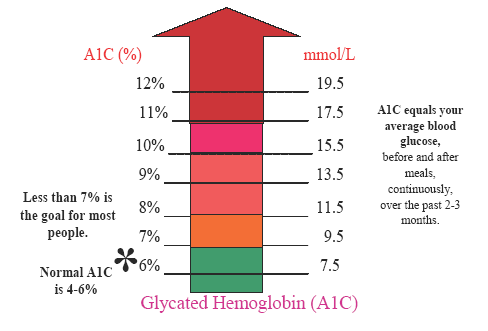Why should my A1C be 7 per cent or less?
Over the last several years a significant amount of research has proven that control matters, and good control is now defined as an A1C of < 7 per cent.
What is an A1C?
An A1C test shows your blood glucose control over the last 2 or 3 months.

Diabetes Control & Complications Trial (DCCT) 1982-1993
Research from both the Diabetes Control & Complications Trial (DCCT) and its follow up study (EDIC) proves that having an A1C of 7 per cent is definitely worthwhile for persons with type 1 diabetes.
Exactly 1441 volunteers aged 13 to 39, all with type 1 diabetes, took part. These people agreed to randomly be assigned to either conventional treatment - taking about two insulin injections a day - or to intensive treatment (IT) - taking either multiple dose insulin (MDI, about 4 injections a day) or an insulin pump.
During the study the A1C of each group was compared:
- the conventional therapy group had an average A1C of 9.1 per cent (normal 4-6 per cent)
- the intensive therapy group had an average A1C of 7.2 per cent
The purpose was to finally demonstrate whether or not good blood sugar control was really important to prevent the complications of diabetes. And indeed it is – as you can see below, complications developed at a much lower rate in the intensively treated group compared to the conventional group.
| Effect of intensive therapy on: | Those with no complications at beginning of study: | Those with some complication at beginning of study: |
| Eye Disease (retinopathy) | 76% overall reduction |
54% less progression
|
| Kidney Disease (nephropathy) | 34% less microalbuminuria | 56% less proteinuria |
| Nerve Disease (neuropathy) | 69% less occurrence | 57% less occurrence |
| Heart Disease | Trend towards reduction in risk factors | Trend towards reduction in risk factors |
The reduction in risk for eye disease (the primary outcome) was so great that the study was stopped early – and intensive therapy to achieve an A1C of 7 per cent or less became the standard of practice worldwide!
But what do these results mean for you?
For you, a person with type 1 diabetes, lowering your A1C by 1 per cent means a 45 per cent less risk you will develop the chronic complications of diabetes! That’s 45 per cent for each 1 per cent lower! The closer to normal (<6 per cent) the A1C is the better!
The results also mean that an A1C of <7 per cent will also be good for you if you already have some signs of chronic complications. For example, kidney and eye disease may stay stable for years!
At the end of the original DCCT trial, all the people in the conventional group changed to intensive therapy and their A1C lowered. Then both groups went back to their usual diabetes care teams, coming back to the study centre for a once yearly assessment.
This same group of volunteers has remained in the DCCT follow up study called Epidemiology of Diabetes Interventions & Complications (EDIC) since 1993. Now that’s commitment to a research study!
Over time the A1C of the original intensive therapy and the former conventional therapy groups evened out at an average of 8%, but the benefits of intensive therapy remained – much to everyone’s surprise. And for the first time, the benefits of good control on heart/cardiovascular disease were clearly shown.
DCCT/EDIC Results 1993-2005 (NEJM 2005)
| Original Intensive vs. Conventional Therapy Groups: Comparison of Complications Status |
EDIC 11 yrs of A1C~ 8% Both testing 4 x per day |
| Eyes (retinopathy) | 75% less progression |
| Kidney | 86% risk reduction in onset of new microalbuminuria |
| Heart/ Cardiovascular |
57% less risk of heart attack (MI), stroke or CV death Intensive group: 31 people with 46 events Conventional group: 52 people with 98 events |
The latest results (2005) continue to support the earliest possible adoption of intensive therapy to achieve an A1C of <7 per cent. Early and optimal blood glucose control has long term benefits.
That’s why we believe so passionately in using the IT system, and why we want to help you find the best way for you to do this. We know it isn’t easy to act like a pancreas day in and day out. It‘s hard work – and we want to help!





